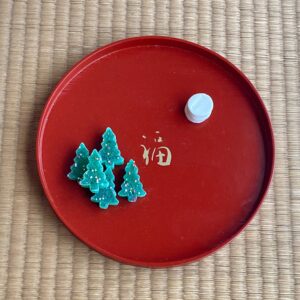Higashi – Sweets for Thin Tea

Sweets are arranged on a maru-bon, 丸盆, round-tray lacquered red throughout, with the Kanji fuku, 福, fortune, written in gold lacquer; diam 6 sun kujira-jaku, from Tachi-kichi, たち吉, Tachi-good luck, Kyōto. The ideal hi-ga-shi bon, 干菓子盆, dry-sweet-of tray, has a diameter of 8 sun kane-jaku or 6.4 sun kujira-jaku.
Higashi are customarily served with usu-cha, 薄茶, thin-tea.
Pictured above are Necco (New England Confectionary Company) wafers are pressed sugar sweets in a variety of colors and flavors that had been made in the Boston area since 1847. Glenn Sōrei Pereira made the little gel trees adorned with colored sugar sprinkles for Christmas.
The sweets on the back right of the tray should be pressed sugar, often called raku-gan, 落雁, alight-geese, and are deemed shin o-ka-shi, 真お菓子, true hon.-sweet-of, as they were given at Shintō shrines and Buddhist temples when sugar was introduced to Japan. The front left sweets can be almost any appropriate higashi that are dry, as they are eaten with the fingers. These sweets are regarded as informal, sō o-ka-shi, 草お菓子, grass (informal) hon.-sweet-of. The gyō, 行, transition, semi-formal, sweet is identified as the omo ga-shi, 主菓子, main sweet-of, that is served before having koi-cha, 濃茶, thick-tea. These sweets are called nama-ga-shi, 生菓子, fresh-sweet-of, which are moist, and are eaten using a kuro-mo-ji, 黒文字, black-letter-character, pick.
Two different sweets are offered to the guests, because guests are encouraged to have two bowls of usucha. The shin sweet is eaten before the first bowl of tea, and the second sweet is eaten before the second bowl of tea. When arranging sweets on a tray, questions may arise as to the number of each of the two different sweets. A rule is to offer an odd number of sweets, however, when both sweets are in odd numbers, they add up to an even number. One group can be odd the other even. One group is orderly, the other is random. There should be extra sō sweets to encourage the guests to have another bowl of usucha. But, most often the guests do not have a third bowl of tea.
The arrangement of the sweets should not create a scene, nor should sweets be placed according to logic. The sweets in the above picture may suggest a scene with the full moon over a forest, however, it is mostly coincidental. A shin pressed sugar sweet that is in the shape of a ‘fish’, together with an informal sō sweet that is a senbei, a griddled wafer made of various kinds of grain, often rice, perhaps with a cloud design, the shin ‘fish’ sweet should be above the sō cloud senbei. Substitutes for pressed sugar sweets are hard to find outside of Japan, hence, the presence of the Necco wafer pictured above.
According to the Eki-kyō, I Ching, 易経, Change-sutra, and its ha-kke, 八卦, eight-signs, called trigrams, the trigram in the back right section of the tray is Shin, 震, shake, thunder, which is wordplay on the Kanji shin, 真, true.
For further study on higashi see pg. 28 of Anatomy of Japanese Tea Ceremony: Five Elements and Ekikyō

